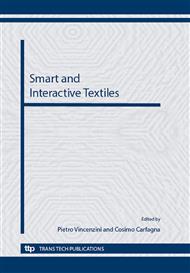[1]
L. Flandin, A. Chang, S. Nazarenko, A. Hiltner, and E. Baer, Effect of strain on the properties of an ethylene-octene elastomer with conductive carbon fillers, Journal of Applied Polymer Science, vol. 76, no. 6, pp.894-905, 2000.
DOI: 10.1002/(sici)1097-4628(20000509)76:6<894::aid-app16>3.0.co;2-k
Google Scholar
[2]
L. Flandin, A. Hiltner, and E. Baer, Interrelationships between electrical and mechanical properties of a carbon black-filled ethylene-octene elastomer, Polymer, vol. 42, no. 2, pp.827-838, Jan.2001.
DOI: 10.1016/s0032-3861(00)00324-4
Google Scholar
[3]
M. Knite, V. Teteris, A. Kiploka, and J. Kaupuzs, Polyisoprene-carbon black nanocomposites as tensile strain and pressure sensor materials, Sensors and Actuators A: Physical, vol. 110, no. 1-3, pp.142-149, Feb.2004.
DOI: 10.1016/j.sna.2003.08.006
Google Scholar
[4]
V.Zucolotto, J.Avlyanov, and L.H.C. Mattoso, Elastomeric conductive composites based on conducting polymer-modified carbon black, Polymer Composites, vol. 25, no. 6, pp.617-621, 2004.
DOI: 10.1002/pc.20056
Google Scholar
[5]
A. M. Kucherskii, Hysteresis losses in carbon-black-filled rubbers under small and large elongations, Polymer Testing, vol. 24, no. 6, pp.733-738, Sept.2005.
DOI: 10.1016/j.polymertesting.2005.04.005
Google Scholar
[6]
P. Gibbs and H. H. Asada, Wearable Conductive Fiber Sensors for Multi-Axis Human Joint Angle Measurements, Journal of NeuroEngineering and Rehabilitation, vol. 2, no. 1, p.7, 2005.
Google Scholar
[7]
T. Alessandro , L. Federico , B. Raphael , Q. Silvana , T. Mario , Z. Giuseppe , and D. De Rossi, Wearable kinesthetic system for capturing and classifying upper limb gesture in post-stroke rehabilitation, Journal of NeuroEngineering and Rehabilitation (JNER), vol. 2, no. 1 2005.
DOI: 10.1186/1743-0003-2-8
Google Scholar
[8]
C. Cochrane, V. Koncar, M. Lewandowski, C. Dufour, Design and development of a flexible strain sensor for textile structures based on a conductive polymer composite, sensors, vol. 7, no. 4, pp.473-492, 2007.
DOI: 10.3390/s7040473
Google Scholar
[9]
F. Martinez, G. Obieta, I. Uribe, T. Sikora, and E. Ochoteco, "Polymer-Based Flexible Strain Sensor," Procedia Chemistry, vol. 1, no. 1, pp.915-918, Sept.2009.
DOI: 10.1016/j.proche.2009.07.228
Google Scholar
[10]
I. A. Estrada Moreno, A. Diaz Diaz, M. E. Mendoza Duarte, and R. I. Gómez, "Strain Effect on the Electrical Conductivity of CB/SEBS and GP/SEBS Composites," Macromolecular Symposia, vol. 283-284, no. 1, pp.361-368, 2009.
DOI: 10.1002/masy.200950943
Google Scholar
[11]
A. Togenetti, F. Lorussi, M. Tesconi, D. de Rossi, Strain sensing fabric characterization, Proceedings of IEEE Sensors vol. 1, 2004, 527 – 530.
DOI: 10.1109/icsens.2004.1426217
Google Scholar
[12]
C. Mattmann, F. Clemens, G. Tröster, "Sensor for Measuring Strain in Textile", Sensors 8 (2008), 3719-3732.
DOI: 10.3390/s8063719
Google Scholar


